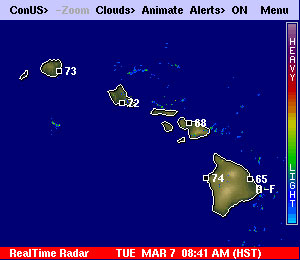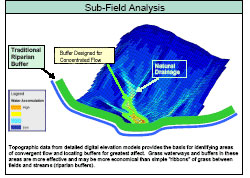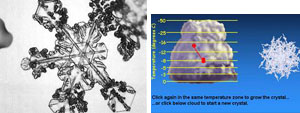Monthly News Summary – March 2006
by Terri Gregory
The redesign of Wisconsin’s non-point pollution control program in 2000-2001 resulted in controversy over the role of riparian buffers, or strips of plants placed alongside lakes and rivers. These buffers reduce water pollution by filtering out sediment and phosphorus from runoff. The controversy, mainly between environmental and agricultural groups, led to the Wisconsin Buffer Initiative (WBI). SSEC researcher Christine Molling became involved in the WBI through a complementary project to quantify phosphorus losses from agricultural fields.
In 2002, the WBI set out to provide a practical, fiscally responsible, scientifically-based plan to regulate the installation of buffers in Wisconsin. Molling and UW-Madison researchers from several departments collaborated with representatives of a wide range of interested groups. The project that inspired Molling’s role in the WBI involved monitoring and modeling sediment and phosphorus in runoff from four Wisconsin family farms and the University of Wisconsin’s Arlington Agricultural Research Farm. A collaborative effort, this project brought together scientists and researchers from UW–Madison’s Soil Science Department, Biological Systems Engineering, and SSEC.
For the WBI, Molling’s group adapted the model used in the preceding monitoring study. The model, called the Precision Agricultural-Landscape Modeling System (PALMS), calculates an indicator known as the contributing area, which estimates how much runoff might leave a field at each point along its boundary. Using detailed topographical maps, the group found that on runoff at the edges of a field varies widely because the farm field is not uniform in slope or shape.
Molling’s calculations of contributing areas led WBI members to recommend that buffers should be designed with contributing areas in mind. If more runoff is expected to leave a field in one location versus another, then the buffer should be wider in the section with the greater contributing area, and can be narrower in the section that contributes less runoff.
Working on a project that brings together several diverse perspectives was a new experience for Molling. “For me it was a unique opportunity to see science go straight to work on an issue that affects every Wisconsin citizen,” Molling said. “And it was also new for me to be forced to deal not just with the scientific aspects of an issue, but the financial, social, and regulatory aspects as well.”
For more information, see the SSEC Media Features page.
Cloud mask goes operational—Clouds from AVHRR Extended (CLAVR-x) is a set of algorithms designed to help NOAA process data from the Advanced Very High Resolution Radiometer (AVHRR). CLAVR-x serves as the pixel-level cloud mask for a number of AVHRR applications and also provides estimates of cloud properties for use in numerical weather prediction. NOAA’s forecasters started to use the cloud mask technique operationally in February. The elements of CLAVR-x that generate cloud products will transfer into operations later this year.
Snowed in—The blizzard that hit Madison on February 16 caused trouble on the roads and prevented many from making it to work the next day. The snow also piled up on SSEC’s antenna over on Orchard Street threatening to interupt the data stream from weather satellites. The antenna on Orchard Street receives data from Meteosat-8, Meteosat-7, and Wallops Polar relay. Recently, the antenna received a coat of special hydrophobic paint to help the snow slide off. This helps for regular snows, but the snow accumulated rapidly during the blizzard. The snow was cleared quickly and the antenna regained its signal strength.
Featured in books about ice —Two recently published books about ice drilling feature members of SSEC’s Ice Coring and Drilling Services (ICDS) and associated ice researchers. Thin Ice: Unlocking the Secrets of Climate in the World’s Highest Mountains, written by Mark Bowen, focuses on the work of climatologist Lonnie Thompson, who cores ice in glaciers to piece together the climate puzzle. In Bowen’s wide-ranging and well-researched book, the basis for “greenhouse science” is found in ice cores taken around the world. Along the way Bowen met up with engineer and ice driller extraordinaireBruce Koci, now with SSEC’s ICDS. While working on AMANDA, an incipient neutrino telescope in the south polar ice, Koci provided Bowen with an education in the history of ice drilling. Bowen notes that Koci was involved with all NSF ice drilling operations and “helped to develop virtually every ice drilling technology that the United States has come to grips with since [1978].”Thin Ice is an adventure story of the endeavors of one scientist and his entourage in unlocking the keys to climate found in deep ice. In passing, Bowen notes the work of emeritus professor Stefan Hastenrath (Dept.of Atmospheric and Oceanic Sciences), who studied glaciers near the equator to see how snow fared in sunlight. He found that it doesn’t melt at high altitudes, even in bright sunlight.
In Ice: The Nature, the History, and the Uses of an Astonishing Substance, Mariana Gosnell covers all the aspects of ice she can consider in 500+ pages. She devotes a chapter to the peculiarities of the West Antarctic Ice Sheet, a site where ICDS will use their largest, most complex drill, the recently completed DISC drill. ICDS principal investigator, geologist Charles Bentley, is one of several scientists she cites as awed by the ice sheet. A chapter covers Antarctica’s large tabular icebergs that have been monitored by SSEC’sAntarctic Meteorological Research Center, whose Matthew Lazzara explains that the calvings were natural occurrences and not due to global warming. Gosnell calls the neutrino telescope, IceCube, “probably the grandest use of ice.” Robert Morse, an ICDS co-investigator, explains that Antarctic ice helps detect the tiny particles indirectly with strings of photodetectors. Icecontains a dramatic photo of ice cores taken by Bruce Koci, who shows up in the chapter, “Coring.” Koci was involved with drills that took cores for theGreenland Ice Sheet Project 2 (GISP2).
In February, Russ Dengel’s PDA Animated Weather service (PAW) continued to receive media attention. The service also attracted new users who gave Dengel more praise and advice.
The Wisconsin Alumni Association’s Online Wisconsin included the PAW in their February e-mail report. Dengel is a UW alum from ’78. The piece appeared under “Eye on Alumni,” and featured a link to the UW press release from January 6.
PAW also appeared on local Channel 3. On February 16-17, a blizzard rolled through Madison, prompting Channel 3 to do a story on the PAW. During the evening broadcast on the 16 th and the morning broadcast on the 17th, Tom Achtor (SSEC) and Wayne Feltz (CIMSS) spoke about the service. Achtor pointed out the different features of the PAW while Feltz discussed a variety of uses. A summary of the story is on Channel 3’s Web site with a link to Dengel’s PAW Web site. Yahoo’s news service also carried the story.
 |
|
Dengel added radar information over Hawaii to the PAW’s arsenal of products.
|
CIMSS Director Steve Ackerman took SSEC’s Treo 700w, a PDA with wireless Internet access, to the 13th annual Ocean Sciences Meeting in Hawaii. Ackerman used the Treo to demonstrate PAW to conference participants. For this purpose, Dengel addedradar and cloudinformation for Hawaii to the PAW’s arsenal of products.
Dengel also recently incorporated forecast radar animations from the CIMSS Regional Assimilation System (CRAS). CRAS is an experimental numerical weather prediction model that incorporates satellite observations.
PAWPrints is a monthly In the News article that details recent publicity and comments about the PAW, and provides an update on new products added to the service.
Diagnosing hurricane intensity—Jim Kossin (CIMSS) recently developed an objective way to diagnose a feature in hurricanes that is associated with significant and frequently rapid intensity changes. Eyewall Replacement Cycles (ERC) detract from the accuracy of intensity predictions. Kossin determined a set of characteristics that signal the beginning of a cycle, and developed an index based on those characteristics. This index will improve hurricane predictions.
Reaching out to teachers—UW–Madison’s Science Alliance outreach group exhibited at the recent conferenceof the Wisconsin Society of Science Teachers. About 250 teachers visited the booth, with everyone taking a Science Expeditions pencil (or three) and Science Expeditions postcards. The small booth featured a PowerPoint presentation showing most Science Alliance member activities as well as useful handouts for teachers. During the two days of the convention, SSEC’s outreach specialist Margaret Mooney staffed the booth with four other Science Alliance members and SSEC public information coordinator Terri Gregory.
During the conference, Mooney presented highpoints of her popular Satellite Meteorology course for teachers and gave away dozens of CDs.
|
Elementary and middle school students used Whittaker and Ackerman’s snowflake applet to learn about snowflake formation. Here is an example of an image of a rimed crystal snowflake and the formation of that type of flake in a cloud as simulated using the applet. |
Studying Snow—Over the years, Tom Whittaker and Steve Ackerman (CIMSS) have developed several online educational tools. Elementary and middle school students in Charleston, IL have picked up one of their applets and incorporated into a project to look at the science and math of snowflake formation. Frosted Flakes: The Science of Snowflakes makes use of Whittaker and Ackerman’s snowflake applet, which helps students figure out the path a flake took through the clouds as it formed. The students gathered snowflake data using digital microscopes, laptops and cameras to track patterns. Whittaker and Ackerman’s applet played a significant role in this project by helping students understand how a flake changes as it makes its way through different temperature layers within the cloud. The project Web site includes the applet. It also references the Bentley Collection, which the staff of the Schwerdfeger Library preserved and made available online.
Star Stories—An innovative planetary education program, “One Sky, Two Views,” has received a lot of attention in the past few months, including a mention in Chancellor John Wiley’s message for the winter edition of Insights. On February 2, the Wisconsin State Journal ran an article about the program on the front page. Native Village, a Native American community Web site, posted part of the story in their “Youth and Education News” section. Sanjay Limaye, Patty Loew and Rosalyn Pertzborn, the program’s coordinators, sent the Wisconsin State Journal a letter of thanks. “We are grateful for Ron Seely’s story and Wisconsin State Journal’s very prominent coverage of our Native American Star stories project. … We are proud that the Madison campus has such a strong commitment for the Wisconsin Idea and it has been a very rewarding experience to share the Native American cultural knowledge and astronomy with students and the public across Wisconsin.”
As noted in UW–Madison’s Wisconsin Week for 1 March 2006, SSEC’sJean Phillips was awarded a Professional Development Grant to attend the Atmospheric Science Librarians International (ASLI) Conference held in Atlanta, GA, 1-2 February 2006. ASLI holds its annual meeting with that of the American Meteorological Society (AMS), the main membership organization of ASLI’s patrons. The meeting provides a forum for information professionals in the atmospheric sciences to communicate through discussions and formal presentations on issues of mutual interest or concern.
Phillips is librarian for SSEC’s special campus library, The Schwerdtfeger Library. She is ASLI chair-elect for 2006 and will be chair in 2007. Her duties include planning the conference for 2007.
Victory in the lanes—Jay Heinzelman (SSEC) breifly left his post as a senior researcher with the McIDAS team to help out another team at the 2006 United States Bowling Congress Open Championship in Corpus Christi, TX. During the doubles competition, Heinzelman bowled the second perfect game of the championship. His score in the doubles and singles helped his team, Ten Pin Alley 2, roll into sixth place overall. Also a member of the SSEC bowling league, Heinzelman has had several perfect games in his bowling career. The United States Bowling Congress recognized Heinzelman in an article on their Web site.


